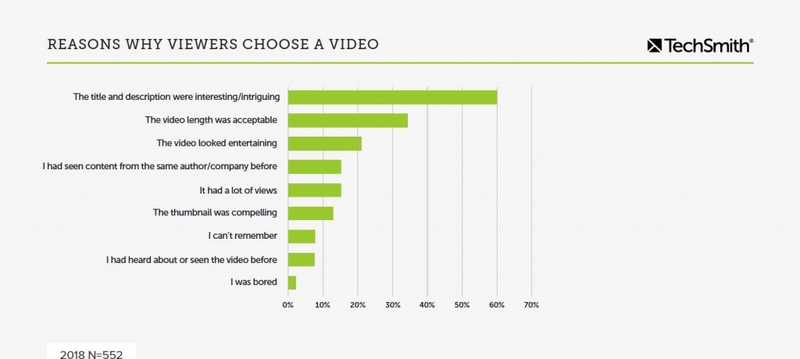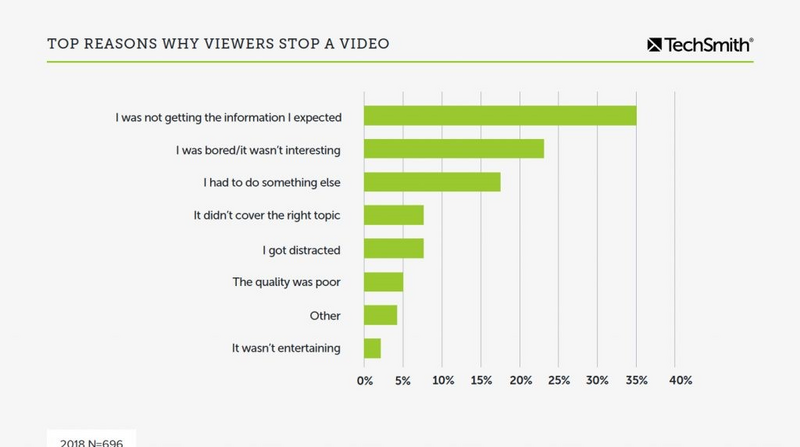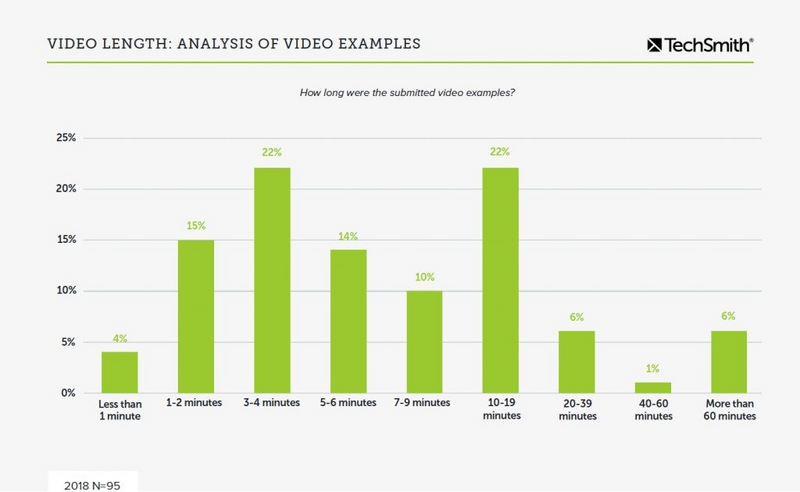ATD Blog
Why People Stop Watching Your Videos—And How to Stop It
Wed May 27 2020

Picture this: You’ve crafted your video, uploaded it, and the views are rolling in. But when you check the viewer stats, you notice something concerning. The engagement stats consistently show people stop watching your video before it ends. Some stay for a few seconds, others a few minutes.
Why?
There are a lot of reasons people stop watching videos. A few of them are out of your control, but there are several things you can do to ensure most people who find your video will stick around until the end.
Video Keeps Trending Up
Whether they want to know how to install a new electrical outlet, learn a new coding language, discover how to make the perfect BBQ, or learn to use your company’s software, people increasingly turn to video for their learning needs. In fact, recent research by TechSmith shows that in 2018, 53 percent of people reported watching an informational or instructional video two or more times per week. That’s more than double the 21 percent who reported the same thing in 2016.
So, if you’re making videos that show someone how to do something, there’s almost certainly an audience who wants to watch. To understand why, let’s look at why they started watching in the first place.
Keep Your Promises
Most people start watching a video because they are interested in the topic or need the information it contains. In other words, they were intrigued by the content the video claimed to provide. The most common way they figure out what your video is about is by reading the title and description.

This is incredibly important. The number 1 reason people start watching a video is an interest in the topic, and the top reason they stop watching is they didn’t get what they wanted. See the problem? Users express this problem in their own words too. In fact, 42 percent of people said they stopped watching a video because they were not getting the information they expected to see or it didn’t cover the right topic.

It’s simple: If you want to keep people watching, your video’s title and description must match the content the video provides.
This may seem obvious, but in this era of clickbait headlines and misplaced emphasis on “going viral,” it’s tempting to maximize your click rates with outrageous claims about your content.
If all you care about is clicks, that’s fine. But if you really want to engage viewers with content that will help them learn something new, deliver what you promise. Write a clear headline and description that accurately depicts the content so people will know what to expect.
Keep It Interesting
Is your video entertaining and engaging? Nearly 25 percent of respondents to TechSmith’s research said that a boring video made them stop watching, making it the second-most-common reason viewers dropped off.
But what if it’s just a boring topic?
Let’s face it: Not every instructional or educational video topic will have your audience on the edge of their seats. Some topics are simply (relatively) boring. But that doesn’t mean your content has to be uninteresting. Even the most mundane topics can be made engaging. Here are a few techniques you can use to keep your viewers engaged:
Tell a story and make it relevant to your audience’s real lives.
Use an engaging speaker or voiceover to present the topic with passion and excitement.
Show your (or someone else’s) face! A visible speaker offers an authentic expert voice in your video. Whether it’s you or someone else, a face can help your viewers relate better to you.
Include practical, real-life examples that your viewers can easily apply to their own lives.
Use effective visuals, like images and icons to illustrate your concepts.
Be mindful of when you repeat information or when you slow down your explanations. Both can be effective, but they can also make your video feel plodding.
Use humor where appropriate.
Use plain language and avoid overly formal expressions or jargon. Explain technical terms in ways that people can easily understand.
Encourage viewers to actively follow along and interact. Post thought-provoking questions or ask for comments, feedback, and other engagement.
Right-Size Your Video
The common wisdom for video length is that shorter is better. But I like to think of it as right-sizing your video—that is, ensuring the video is the right length to cover the topic in the most efficient and effective way.

TechSmith’s study showed that 37 percent of people preferred videos between one and four minutes. That’s unsurprising. But what did surprise us was that 22 percent of people showed a preference for videos between 10 and 19 minutes in length. That’s the same percentage of people who prefer videos between three and four minutes.
So, it’s not just that people want short videos. People will watch a longer video, but it must be engaging, entertaining, and provide the information they need in a way that’s understandable and relevant.
Here are a few tips to ensure your video is the right length:
Know your audience as well as their needs and expectations.
Don’t try to do too much (or too little).
Have a goal and create content that meets that goal.
Audio, the Surprise Important Element
As part of our research, we analyzed nearly 100 videos submitted to us by survey participants as examples of great videos. Roughly 75 percent of the videos submitted that were deemed great videos, clear audio was the most common element.

But that’s not all. Videos that received a four- or five-star rating for “How accurately did the video achieve its goal?” and “How did you personally rate the video?” had even higher percentages of clear audio at 89 percent. So, while people may not stop watching a video because the audio is bad, good audio appears to keep people watching.
Make sure your audience can clearly hear and properly understand anyone speaking in your video. If you have music in your video, keep it far enough in the background that it doesn’t drown out your speaker.
You don’t need a professional recording studio to achieve good voice-over audio. A low-cost microphone and a quiet place to record can make a huge difference.
Video Quality: The Surprise Not-So-Important Element
Probably the biggest surprise to come out of our study of video viewer habits was that video quality wasn’t a huge reason that people stopped watching videos. In fact, just 5 percent of respondents reported they stopped watching a video because the quality was poor.
What does that mean for you? It means you don’t need super-fancy gear to make effective videos that people will watch.
Take our YouTube channel, for example. We used to focus solely on posting videos made by our in-house video professionals. But recently, with more of our folks working from home, we’ve started making videos right from the comfort of our own houses. And as a result, our channel is growing!
You don’t need perfect video lighting and fancy equipment. You just need to get started. If you have a smartphone, screen-recording software, a decent microphone, and a good video editor like Camtasia, you can make highly effective, engaging, and informative videos.
Keep ‘Em Watching
You have information to exchange, things to teach, and knowledge to share, but if people stop watching your videos before the end, they may miss out on what you’re trying to show.
By following the tips in this article, you can ensure that you’re doing everything in your power to meet your audience’s expectations with a video that keeps their attention and gives them the information they need in the most efficient and effective manner.
To learn more about how to make the best informational and instructional videos, join my session during ATD Virtual Conference.
Editor's note: This post was originally published on the TechSmith blog.
You've Reached ATD Member-only Content
Become an ATD member to continue
Already a member?Sign In
